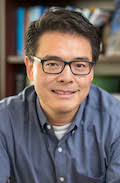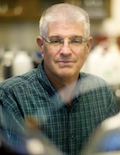UT Arlington Joins Project to Prevent DFW Airport Flooding
(UC) — The University of Texas at Arlington (UTA) is partnering with Dallas Fort Worth International Airport as it takes proactive steps to manage storm water and flooding at the airport.

Nick Fang, assistant professor of civil engineering at UTA, oversees a five-year, $1.5 million project to:
• Help improve storm water management strategies and runway operations,
• Perform systematic evaluations of green storm water infrastructure on airport property, and
• Develop an advanced flood warning system that mitigates potential issues before they happen.
“The airport has runways, taxiways and buildings that are built with massive concrete. When you have impervious surfaces like that, water can’t seep through the ground, so there’s a higher chance of flooding on the property,” Fang said.“DFW Airport doesn’t have issues with severe flooding at the moment, but adding more impervious areas and reducing permeable areas could potentially cause increased flooding as the airport continues to grow."

Andy Kruzic and Xinbao Yu, associate professors of civil engineering, are co-investigators on the project.
UTA is “a valued resource for this important initiative,” said Eduardo N. Tovar, P.E., manager of systems performance at DFW Airport.
“The Airport’s commitment to sustainable efforts touches many issues, including the importance of storm water quality and drainage in this region,” Tovar said.
“Working with a partner that shares our commitment to strong, progressive and knowledgeable management of storm water—to ensure infrastructure addresses the need for efficient and safe drainage and supports the need to protect storm water quality—is important,” he said.
As part of the project, Fang and his team will:

• Investigate the First Flush Stormwater System. When runoff is collected from impervious areas such as ramps, runways and taxiways, it has to go to a pre-treatment plant. Fang and his team will collect samples from throughout the system for monitoring.
• Evaluate the benefits, in terms of infiltration rates and retaining capacities, of the airport’s green storm water infrastructure.
• Evaluate channel erosion. Given the natural soil conditions of the airport property, its channels are inevitably subject to natural erosion. The team will use several measures, such as deploying unmanned aerial vehicles to survey and collect geometric data, to model and analyze erosion processes and make recommendations for mitigating channel erosion issues.
• Provide recommendations for optimal storm water mitigation alternatives.
• Develop a web-based flood warning system for emergency personnel.
• Develop a toolkit that will incorporate weather-related parameters into a web-based dashboard to assist in decisions involving when to apply anti-icing media on runways and taxiways during winter weather conditions.
“We are happy to have the opportunity to team with DFW International Airport on this important project,” said James Grover, UTA’s interim vice president for research. “UTA is uniquely suited to this research, with several experts in urban water systems and flooding. Dr. Fang’s experience with storm water runoff in Houston during Hurricane Harvey will inform many of his processes and recommendations.”
Related News
From Archive

- Glenfarne Alaska LNG targets late-2026 construction start for 807-mile pipeline project
- U.S. water reuse boom to fuel $47 billion in infrastructure spending through 2035
- $2.3 billion approved to construct 236-mile Texas-to-Gulf gas pipeline
- Major water pipe break in Puerto Rico hits over 165,000 customers
- Potomac River Tunnel project enters construction phase beneath Washington, D.C.
- Pennsylvania American Water launches interactive map to identify, replace lead water service lines
- Trump's tariffs drive $33 million cost increase for Cincinnati sewer project
- Utah city launches historic $70 million tunnel project using box jacking under active rail line
- Tulsa residents warned after sewer lines damaged by boring work
- Fatal trench collapse halts sewer construction in Massachusetts; two workers hospitalized



Comments